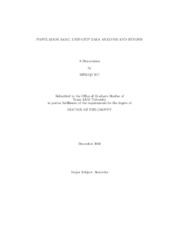| dc.description.abstract | This dissertation research consists of two topics, population stochastics approximation Monte Carlo (Pop-SAMC) for Baysian model selection problems and ChIP-chip data analysis. The following two paragraphs give a brief introduction to each of the two topics, respectively.
Although the reversible jump MCMC (RJMCMC) has the ability to traverse the space of possible models in Bayesian model selection problems, it is prone to becoming trapped into local mode, when the model space is complex. SAMC, proposed by Liang, Liu and Carroll, essentially overcomes the difficulty in dimension-jumping moves, by introducing a self-adjusting mechanism. However, this learning mechanism has not yet reached its maximum efficiency. In this dissertation, we propose a Pop-SAMC algorithm; it works on population chains of SAMC, which can provide a more efficient self-adjusting mechanism and make use of crossover operator from genetic algorithms to further increase its efficiency. Under mild conditions, the convergence of this algorithm is proved. The effectiveness of Pop-SAMC in Bayesian model selection problems is examined through a change-point identification example and a large-p linear regression variable selection example. The numerical results indicate that Pop- SAMC outperforms both the single chain SAMC and RJMCMC significantly.
In the ChIP-chip data analysis study, we developed two methodologies to identify the transcription factor binding sites: Bayesian latent model and population-based
test. The former models the neighboring dependence of probes by introducing a latent indicator vector; The later provides a nonparametric method for evaluation of test scores in a multiple hypothesis test by making use of population information of samples. Both methods are applied to real and simulated datasets. The numerical results indicate the Bayesian latent model can outperform the existing methods, especially when the data contain outliers, and the use of population information can significantly improve the power of multiple hypothesis tests. | en |


